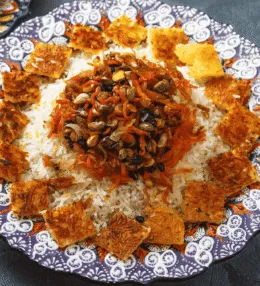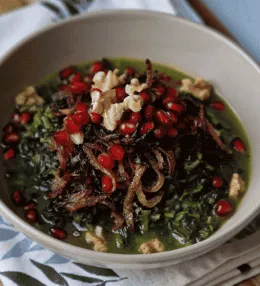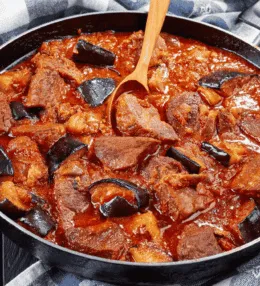
- View
Table of Contents
ToggleStep into any traditional pub across Lancashire on a cold evening, and you’ll likely encounter the rich aroma of slow cooked lamb mingling with earthy vegetables. This isn’t just any ordinary stew; it’s Lancashire hotpot, a dish that embodies the soul of northern England’s culinary heritage.
Born from necessity and perfected through generations, this humble casserole has sustained working families through countless harsh winters. Lancashire hotpot represents the essence of British comfort food at its finest.
Unlike flashier dishes that compete for attention, this unpretentious meal quietly delivers warmth and satisfaction in every spoonful. Its enduring popularity speaks volumes about the power of simple, honest cooking that prioritises flavour over fancy presentation.
Want to dive deeper into British Cuisine? Don’t miss our post on Traditional British Foods to Try
What Is Lancashire Hotpot?
Lancashire hotpot is essentially a layered casserole that transforms simple ingredients into something truly special through patient cooking. The dish features tender lamb pieces nestled beneath layers of thinly sliced potatoes, all slow baked in a traditional brown earthenware pot.
The cooking vessel itself plays a crucial role, its thick walls distributing heat evenly whilst the narrow opening minimises moisture loss. The preparation follows a time-honoured method: lamb pieces are arranged in the bottom of the pot, often with onions and sometimes carrots or celery.
The potatoes are then carefully layered on top, slightly overlapping like roof tiles. During the long, slow cooking process, the lamb juices bubble upward, infusing the potatoes whilst the top layer develops a beautiful golden crust.
Ingredients and Taste
Traditional Lancashire hotpot relies on just a handful of quality ingredients, each playing a vital role in the final result. Lamb shoulder or neck provides rich, full-bodied flavour that only improves with slow cooking. These tougher cuts become wonderfully tender when given time.
The potatoes serve a dual purpose, acting both as a topping and as a natural thickener. As they cook, the lower layers partially break down, creating a creamy base that contrasts beautifully with the crispy upper layer. Some recipes include lamb kidneys for extra depth.
When properly made, Lancashire hotpot offers a symphony of textures and flavours. The top layer of potatoes provides satisfying crunch, giving way to creamy, herb scented layers beneath. The lamb practically melts in your mouth, its rich juices having slowly permeated every element.
A Taste of History
Lancashire Hotpot has its roots in the industrial north of England during the nineteenth century. It was a meal designed for working families who needed something filling, affordable, and able to cook gently while other tasks were done.
The slow oven baking made it practical, as families could prepare the pot in the morning and return to a ready meal later in the day. Its ingredients reflected what was locally available and affordable, especially lamb from nearby farms.
The topping of sliced potatoes became a defining feature during a time when they were a staple crop in northern England. The potato not only stretched the dish further but also added substance and a crisp texture when baked.
Today, Lancashire Hotpot remains closely tied to its regional identity. It is served in pubs, restaurants, and homes, often without alteration to its original method. Each serving is a reminder of the resilience and resourcefulness of northern kitchens.
How to Make Lancashire Hotpot (Lamb and Potato Stew)
Lancashire Hotpot is a classic dish from North West England, slow cooked to perfection with tender lamb, onions, and carrots beneath a golden potato crust. Expect rich, savoury depth and a comforting texture that develops as it bakes gently in the oven. See the recipe card at the bottom for printable directions
Ingredients
For the hotpot
- 800g lamb shoulder, trimmed and cut into chunks
- 2 tbsp plain flour
- 2 tbsp dripping or unsalted butter
- 2 large onions, thinly sliced
- 2 carrots, sliced into rounds
- 1 bay leaf
- 2 tsp fresh thyme leaves (or 1 tsp dried thyme)
- 600ml lamb or beef stock
- 900g floury potatoes, peeled and thinly sliced
- Salt and freshly ground black pepper
For finishing
- 25g unsalted butter, melted (for brushing potatoes)
Cooking Instructions
Step 1: Preheat and prepare
To begin, preheat your oven to 170°C (150°C fan). Dust the lamb chunks lightly with flour, coating evenly. This helps the meat brown properly and thickens the stew later. Proceed to browning.
Step 2: Brown the lamb
Heat dripping or butter in a heavy casserole dish. Add the lamb pieces in batches, searing until golden on all sides. Avoid overcrowding the pan. Remove and set aside. Transition to softening vegetables.
Step 3: Cook the onions and carrots
In the same pan, add onions and carrots. Cook over medium heat until softened and lightly caramelised. This step enhances the sweetness and depth of the hotpot. Prepare to layer.
Step 4: Begin layering the hotpot
Return the lamb to the dish. Season with salt, pepper, thyme, and add the bay leaf. Pour in stock, ensuring the meat and vegetables are just covered. Bring to a gentle simmer. Prepare potatoes next.
Step 5: Arrange the potatoes
Layer the sliced potatoes neatly on top of the lamb and vegetables, overlapping them in a circular pattern. Keep the slices tight and even for a traditional finish. Move to brushing.
Step 6: Brush with butter
Brush the potato layer generously with melted butter. This will create the signature golden crust. Cover with a lid or foil. Transition to oven cooking.
Step 7: Bake slowly
Place the dish in the oven and bake for 1½ hours. The slow cooking allows the lamb to tenderise while flavours meld together. Remove the lid for the next stage.
Step 8: Crisp the topping
After 1½ hours, remove the lid and increase the oven to 200°C (180°C fan). Continue baking uncovered for 30–40 minutes until the potatoes are crisp and golden. Prepare for serving.
Final Step: Serve the hotpot
Rest the hotpot for 5–10 minutes before serving. Present with pickled red cabbage or seasonal greens for a traditional pairing. Garnish with a sprig of thyme if desired.
Variations and Substitutions
- Use mutton instead of lamb for a stronger, more traditional flavour.
- If dripping is unavailable, substitute with goose fat or unsalted butter.
- Replace lamb stock with beef stock if needed.
- Add turnips or parsnips for a heartier vegetable base.
Cooking Tips for Perfect Lancashire Hotpot
- Slice potatoes thinly and evenly for uniform cooking and crisp edges.
- Always brown the lamb properly; it adds depth to the final flavour.
- Cook the dish slowly and gently to achieve tender meat and balanced taste.
- Let the hotpot rest briefly after baking to allow flavours to settle.

Lancashire Hotpot (Lamb and Potato Stew)
Ingredients
For the hotpot
- 800 g lamb shoulder trimmed and cut into chunks
- 2 tbsp plain flour
- 2 tbsp dripping or unsalted butter
- 2 large onions thinly sliced
- 2 carrots sliced into rounds
- 1 bay leaf
- 2 tsp fresh thyme leaves or 1 tsp dried thyme
- 600 ml lamb or beef stock
- 900 g floury potatoes peeled and thinly sliced
- Salt and freshly ground black pepper
For finishing
- 25 g unsalted butter melted (for brushing potatoes)
Instructions
- To begin, preheat your oven to 170°C (150°C fan). Dust the lamb chunks lightly with flour, coating evenly. This helps the meat brown properly and thickens the stew later. Proceed to browning.
- Heat dripping or butter in a heavy casserole dish. Add the lamb pieces in batches, searing until golden on all sides. Avoid overcrowding the pan. Remove and set aside. Transition to softening vegetables.
- In the same pan, add onions and carrots. Cook over medium heat until softened and lightly caramelised. This step enhances the sweetness and depth of the hotpot. Prepare to layer.
- Return the lamb to the dish. Season with salt, pepper, thyme, and add the bay leaf. Pour in stock, ensuring the meat and vegetables are just covered. Bring to a gentle simmer. Prepare potatoes next.
- Layer the sliced potatoes neatly on top of the lamb and vegetables, overlapping them in a circular pattern. Keep the slices tight and even for a traditional finish. Move to brushing.
- Brush the potato layer generously with melted butter. This will create the signature golden crust. Cover with a lid or foil. Transition to oven cooking.
- Place the dish in the oven and bake for 1½ hours. The slow cooking allows the lamb to tenderise while flavours meld together. Remove the lid for the next stage.
- After 1½ hours, remove the lid and increase the oven to 200°C (180°C fan). Continue baking uncovered for 30–40 minutes until the potatoes are crisp and golden. Prepare for serving.
- Rest the hotpot for 5–10 minutes before serving. Present with pickled red cabbage or seasonal greens for a traditional pairing. Garnish with a sprig of thyme if desired.
Nutrition
You May Also Like







Leave a Review